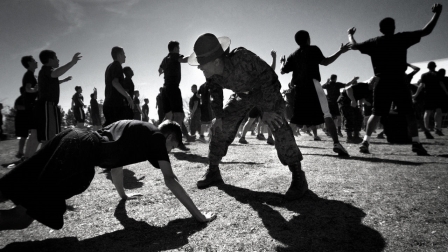The Resilience Habit I Taught Thousands Of Army Drill Sergeants
“Ma’am, I’m a 36-delta, a pathfinder, and this is my buddy here, he’s a 68-whiskey, ma’am.”
This was the precise response I got from two soldiers I met during my first resilience training with the U.S. Army. I’d simply asked them, “What do you do?”
It was 2009, and I’d recently left my law practice to join a team of University of Pennsylvania researchers. Our job was to teach resilience skills to soldiers and their spouses, and during my nearly four years with the project we collectively trained more than 20,000 soldiers (both non-commissioned officers and officers).
Over a 10-day seminar, we introduced service members—many of them drill sergeants—to what’s called the “train-the-trainer” model. Once they graduated the course as MRTs (master resilience trainers), they were required to return to their units and teach the same skills to their fellow soldiers. Here’s a look at the piece of that training that had the biggest impact.
Showing Soldiers What Resilience Is Made Of
The soldiers often arrived with a minimal understanding of what resilience is, so we started each training with an overview. “Resilience” is defined as a person’s capacity for stress-related growth, and there are two key aspects to it.
The first is durability—effectively managing life’s everyday stressors and challenges, like running out of a meeting at the last minute to pick up your child from daycare, or surviving horrendously long TSA lines at the airport without flipping out. The second is bouncing back—the capacity to recover effectively and grow from life’s biggest adversities, like death or divorce.
Your resilience grows when you focus on developing specific skills in the following three categories: thinking differently, connecting more, and staying energized and motivated. Those may sound pretty abstract, so here’s how each one works in practice:
1. Thinking differently. In order to develop resilience, you have to understand how you think about adversity, stress, and challenging situations. Our team taught the soldiers to understand how to think more flexibly and accurately about stress, framed around the “three P’s” from American psychologist Dr. Martin Seligman’s work:
- Personalization
- Permanence
- Pervasiveness
Basically, what that means is that anytime something goes wrong—whether it’s a flat tire or something far more serious—pessimistic thinkers explain the stress like this: “This will be around forever, it will impact multiple areas of my life, and it’s all my fault.” In other words, they personalize it and see the fallout as being permanent and everywhere.
Your explanations can range from optimistic to pessimistic and fall along a continuum. Seligman’s research has shown that consistent pessimistic explanations are associated with an increased likelihood of depression, anxiety, hopelessness, and helplessness. So the goal of thinking differently in resilience training is to push back against this type of pessimistic reasoning.
2. Connecting more. I learned a new term working with the soldiers: “battle buddy.” A battle buddy is another person a soldier can count on in any type of situation. Developing high-quality relationships is critical to living a happy, healthy, and resilient life because of the benefits they provide. Resilience experts typically identify four: they’re empowering, they provide a sense of trust, they let you be your authentic self, and they’re built on respect.
3. Staying energized and motivated. Resilience demands incorporating recovery into your daily routine. “Recovery” is simply the process that brings your functioning back to pre-stressor levels. You’ve recovered when your work-related strains are reduced. That means that it’s often not enough just to go home and take a break. Optimal recovery is a combination of both internal recovery—the short breaks you take while you’re at work—and external recovery, how you spend your time after work, on the weekends, and on vacation.
Finally, staying energized and motivated also means being connected to a source of meaning. People who believe that their lives have meaning and purpose share a whole host of healthy benefits: They’re happier, feel more in control over their lives and more engaged at work, and they report less depression, anxiety, and workaholism.
One Habit That Works
While we taught many skills to the soldiers, one of their favorites (and my personal favorite) was a technique that I first learned in my master’s program. It’s a relationship-building habit called “active constructive responding,” based on Dr. Shelly Gable’s work. Her research shows that how you respond to a person’s good news is just as important for your relationship as the way you respond to that person’s bad news.
Gable and her team have identified four different response styles to the sharing of good news, which we taught to service members—many of whom, it goes without saying, were trained to deal effectively and rationally with very bad news.
1. Passive constructive. You offer distracted, understated support, which kills the conversation. Think of how many times you’re preoccupied with your smartphone when someone tries to share good news with you. This reaction leaves the sharer feeling misunderstood and unimportant.
2. Passive destructive. You one-up the person, ignore their good news, or take over the conversation and make it about you. Many people inadvertently use this response style when they have good news that’s in common with the sharer’s.
3. Active destructive. You get negative when the person shares good news, and leave them feeling angry and even embarrassed. If you’re truly concerned about what somebody takes as good news (but you don’t) spend a few minutes “actively constructively” responding to it, then pick a separate time and place to have a follow-up conversation that’s more critical.
4. Active constructive. This is the only response style that builds solid relationships. You help the sharer relive the good news by showing an authentic interest and asking questions. This benefits both of you because it generates positive emotions; both people walk away from the conversation feeling better.
The soldiers would practice this skill with each other and their families each night, and the impact was profound. After all, this isn’t something many of us think about doing intentionally. Many of the soldiers I worked with later said their relationships with their significant others, their commands, and especially with their kids changed soon after implementing this habit.
Stress and adversity is a consistent theme of life. Simple tools will help you become more resilient to both the small and large adversities life throws your way.
Paula Davis-Laack is a speaker, lawyer, and expert on work-related stress, burnout, and resilience. Follow her on Twitter at @pauladavislaack.
Fast Company , Read Full Story
(52)













